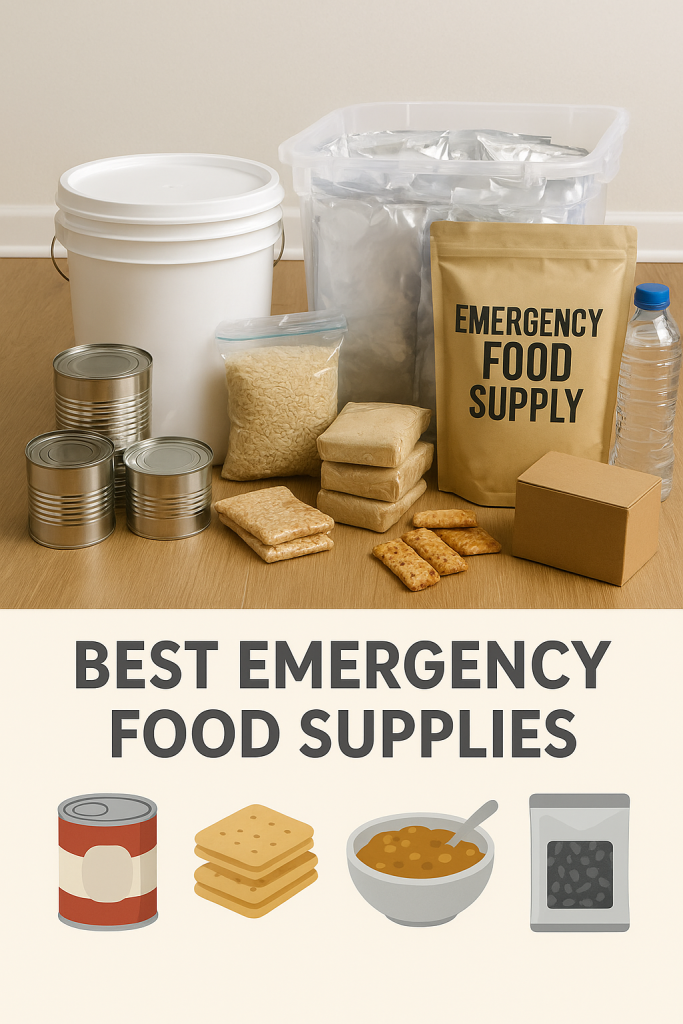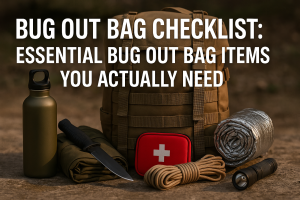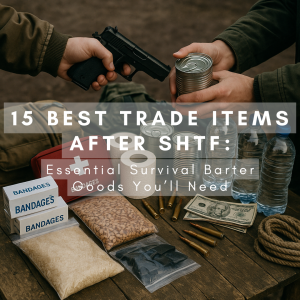Introduction: Why Emergency Food Supplies Are Essential
In today’s unpredictable world, having the best emergency food supplies on hand is no longer optional, it’s a necessity. Whether it’s a hurricane, wildfire, power outage, or even an unexpected job loss, emergencies can disrupt access to fresh food. That’s where well-stocked emergency food kits and storage supplies come in.
Preparedness doesn’t just mean surviving, it means thriving under difficult conditions. By planning ahead with nutrient-dense, long-lasting food supplies, you ensure peace of mind for yourself and your family.

Understanding Emergency Preparedness
The Importance of Food Security During Disasters
When disaster strikes, grocery store shelves empty quickly. Supply chains may break down, and fresh food may spoil without refrigeration. Having reliable emergency food supplies ensures you have enough calories and nutrients to keep going, even when the world outside is uncertain.
Common Scenarios Requiring Emergency Food Supplies
- Natural disasters like hurricanes, earthquakes, floods, and wildfires
- Long-term power outages
- Economic crises or inflation spikes
- Camping, hiking, or survival expeditions
- Global events affecting food distribution
Key Features to Look for in the Best Emergency Food Supplies
When evaluating food supplies, don’t just grab the first bucket or can you see online. Consider these key factors:
Shelf Life and Expiration Dates
Some emergency food lasts 5 years, while premium freeze-dried options can last up to 25 years if stored properly.
Nutritional Value and Calories
Calories keep you alive, but nutrients keep you healthy. Choose food kits that balance carbs, protein, fats, and vitamins.
Packaging and Storage Options
Look for vacuum-sealed, oxygen-free containers. Buckets with mylar bags are best for bulk supplies.
Ease of Preparation
During an emergency, you may not have a full kitchen. Foods that require minimal water or heat (like MREs or energy bars) can be lifesavers.
Categories of Emergency Food Supplies
Freeze-Dried Meals
Lightweight, long-lasting, and tasty. Popular for both survivalists and campers.
MREs (Meals Ready-to-Eat)
Military-style meals designed for portability and convenience. No cooking required.
Canned Foods
Affordable and widely available. Great for building a quick pantry.
Bulk Staples (Rice, Beans, Grains)
Low-cost, calorie-dense foods that can last decades when stored properly.
Energy Bars and Snacks
Perfect for quick energy boosts during short emergencies or evacuation situations.
Top 10 Best Emergency Food Supplies in 2025

When selecting the best emergency food supplies, you’ll want a combination of taste, shelf life, nutrition, and convenience. Below are some of the most reliable options available in 2025.
#1 Mountain House Classic Bucket
- Why it’s great: Lightweight, freeze-dried meals with a 30-year shelf life.
- Pros: Easy to prepare, just add hot water. Includes breakfast, lunch, and dinner options.
- Best for: Long-term storage and camping enthusiasts.
#2 Augason Farms 30-Day Emergency Food Supply
- Why it’s great: Affordable option for individuals.
- Pros: 1,800+ calories per day, packed in a sturdy bucket.
- Best for: Budget-conscious preppers and small households.
#3 ReadyWise Emergency Food Supply
- Why it’s great: Variety-packed kits that focus on taste and nutrition.
- Pros: 25-year shelf life, resealable mylar pouches.
- Best for: Families who want versatile meal options.
#4 Legacy Food Storage
- Why it’s great: One of the largest servings-per-bucket ratios.
- Pros: GMO-free, high in calories per serving.
- Best for: Families preparing for extended emergencies.
#5 Nutrient Survival Food Kits
- Why it’s great: Focused on nutrient density rather than just calories.
- Pros: Designed with survival nutrition in mind (omega-3, vitamins, protein).
- Best for: Health-conscious individuals who don’t want to sacrifice nutrition.
#6 Emergency Canned Meats
- Why it’s great: Reliable protein source when fresh meat isn’t available.
- Pros: Shelf life of 10+ years, provides vital protein and fats.
- Best for: Adding protein variety to a long-term food plan.
#7 Energy and Protein Bars
- Why it’s great: Compact, calorie-dense, and ready to eat.
- Pros: Long shelf life, lightweight, perfect for bug-out bags.
- Best for: Short-term emergencies, evacuations, and hiking.
#8 DIY Bulk Grains and Legumes
- Why it’s great: Cost-effective, highly customizable.
- Pros: Rice, beans, oats, and lentils can last 25+ years in sealed mylar bags.
- Best for: Preppers who want to build a sustainable pantry.
#9 Survival Garden Seeds
- Why it’s great: True long-term self-sufficiency solution.
- Pros: Non-GMO heirloom seeds let you grow food indefinitely.
- Best for: Homesteaders and anyone planning for extended emergencies.
#10 Water Filtration and Storage Solutions
- Why it’s great: Food isn’t useful without safe drinking water.
- Pros: Water filters (like LifeStraw or Berkey) ensure clean hydration.
- Best for: Every emergency kit, hydration is survival priority #1.
Storing Your Emergency Food Supplies Properly
A well-chosen emergency food supply can spoil quickly if stored incorrectly.
Best Storage Locations
- Cool, dark areas like basements or closets.
- Avoid garages or attics, where temperature swings are extreme.
Protecting Against Moisture, Light, and Pests
- Use mylar bags with oxygen absorbers for dry goods.
- Store buckets off the floor to prevent water damage.
- Rodent-proof your storage with sealed containers.
Rotation and Usage Tips
- Follow the “first in, first out” rule (use older stock first).
- Regularly check expiration dates and replace accordingly.
Budget-Friendly Options for Building an Emergency Pantry
Not everyone can afford a $1,000 survival kit but you don’t need to spend a fortune.
- Buy canned goods on sale at local grocery stores.
- Stockpile rice, beans, oats, and pasta in bulk.
- Add peanut butter, powdered milk, and honey for inexpensive, nutrient-rich staples.
- Build slowly, set aside $10–$20 per week toward your emergency food stash.
Common Mistakes to Avoid When Choosing Emergency Food
- Focusing only on calories: Nutrients are equally important.
- Ignoring water needs: Some foods require water to prepare, plan accordingly.
- Not testing meals first: Don’t wait until a crisis to discover you dislike the food.
- Improper storage: Heat, moisture, and pests can ruin your supply.
FAQs About the Best Emergency Food Supplies
Q1. How much emergency food should I store per person?
A minimum of two weeks’ worth is recommended, but most experts suggest at least 30 days per person.
Q2. What’s the longest-lasting emergency food?
Freeze-dried meals and sealed bulk grains stored in mylar bags with oxygen absorbers can last 25+ years.
Q3. Are MREs a good option for home storage?
Yes, but they’re heavy, expensive, and typically have a shorter shelf life (5–7 years). They’re best for mobility and short-term emergencies.
Q4. Can I make my own emergency food supply instead of buying kits?
Absolutely! Many preppers create DIY kits with rice, beans, pasta, and canned goods. It’s cheaper and customizable.
Q5. How do I know if my stored food has gone bad?
Check for unusual odors, discoloration, swelling cans, or broken seals. If in doubt, throw it out.
Q6. Do I need to store water with my food supply?
Yes, plan for at least 1 gallon per person per day for drinking and cooking.
Conclusion: Building a Reliable Emergency Food Supply for Peace of Mind
The best emergency food supplies combine long shelf life, balanced nutrition, and ease of preparation. Whether you choose freeze-dried meals, canned goods, or DIY bulk storage, what matters most is having a plan. Start small, build consistently, and store your food properly.
By preparing now, you ensure security, resilience, and peace of mind for yourself and your loved ones when the unexpected happens.
🔗 External Resource: For more preparedness tips, check out the Ready.gov official emergency food guidance.





